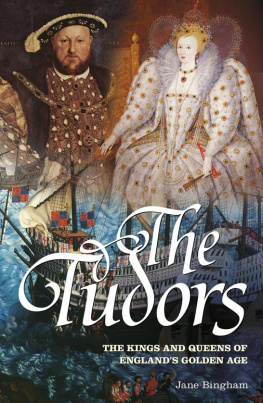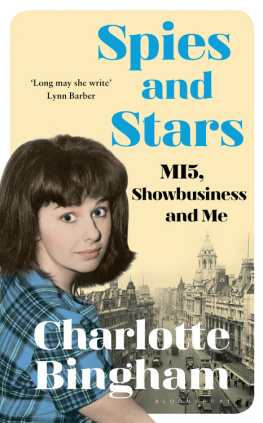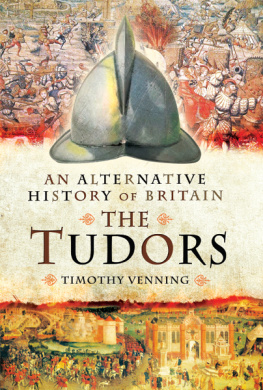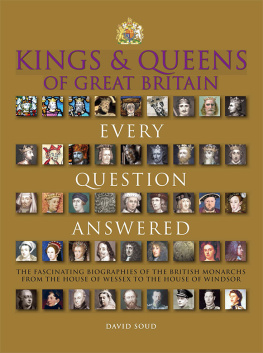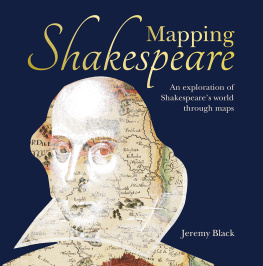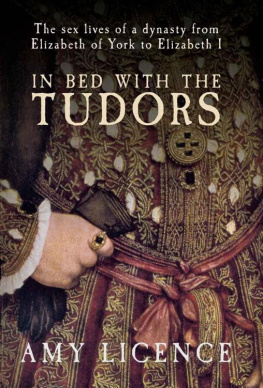Bingham - The Tudors: Kings & Queens of Englands Golden Age
Here you can read online Bingham - The Tudors: Kings & Queens of Englands Golden Age full text of the book (entire story) in english for free. Download pdf and epub, get meaning, cover and reviews about this ebook. year: 2012, publisher: Arcturus Publishing, genre: Home and family. Description of the work, (preface) as well as reviews are available. Best literature library LitArk.com created for fans of good reading and offers a wide selection of genres:
Romance novel
Science fiction
Adventure
Detective
Science
History
Home and family
Prose
Art
Politics
Computer
Non-fiction
Religion
Business
Children
Humor
Choose a favorite category and find really read worthwhile books. Enjoy immersion in the world of imagination, feel the emotions of the characters or learn something new for yourself, make an fascinating discovery.
- Book:The Tudors: Kings & Queens of Englands Golden Age
- Author:
- Publisher:Arcturus Publishing
- Genre:
- Year:2012
- Rating:3 / 5
- Favourites:Add to favourites
- Your mark:
- 60
- 1
- 2
- 3
- 4
- 5
The Tudors: Kings & Queens of Englands Golden Age: summary, description and annotation
We offer to read an annotation, description, summary or preface (depends on what the author of the book "The Tudors: Kings & Queens of Englands Golden Age" wrote himself). If you haven't found the necessary information about the book — write in the comments, we will try to find it.
The Tudors: Kings & Queens of Englands Golden Age — read online for free the complete book (whole text) full work
Below is the text of the book, divided by pages. System saving the place of the last page read, allows you to conveniently read the book "The Tudors: Kings & Queens of Englands Golden Age" online for free, without having to search again every time where you left off. Put a bookmark, and you can go to the page where you finished reading at any time.
Font size:
Interval:
Bookmark:
The Tudors
Jane Bingham


This edition published in 2012 by Arcturus Publishing Limited
26/27 Bickels Yard, 151153 Bermondsey Street, London SE1 3HA
Copyright 2012 Arcturus Publishing Limited
All rights reserved. No part of this publication may be reproduced, stored in a retrieval system, or transmitted, in any form or by any means, electronic, mechanical, photocopying, recording or otherwise, without prior written permission in accordance with the provisions of the Copyright Act 1956 (as amended). Any person or persons who do any unauthorised act in relation to this publication may be liable to criminal prosecution and civil claims for damages.
Picture Credits
Images courtesy of Corbis, Bridgeman Art Library and Getty. For more information contact info@arcturuspublishing.com.
ISBN: 978-1-78212-105-3
AD002432EN
Contents
Chapter 1 : Fighting for the Crown
The battlefield at Bosworth was scattered with the bodies of the wounded, dead and dying. For almost three hours, the armies of York and Lancaster had fought tenaciously, but now the bloody struggle was over. And in the midst of the carnage lay King Richard III, the last English monarch to die in battle.
Richard had worn his crown proudly into battle, and as he lay dying so the chroniclers said it had rolled away under a hawthorn bush. When the fighting was done, the muddy crown was rescued and placed on the head of the young victor. It was a crucial moment in English history. As Henry Tudor accepted the English crown, the Wars of the Roses came to an end and the Tudor era began.
The dynasty that Henry Tudor founded would rule for more than a hundred years, presiding over a golden age of music, art and literature. Under the Tudors, England experienced peace and prosperity, transforming itself from an obscure northern kingdom into a major player in European politics. But who was Henry Tudor and how did he come to claim the English throne?

The Wars of the Roses Fighting for the Crown
Between the years 1455 and 1485 a bitter power struggle was waged between two branches of the Plantagenet dynasty of the English royal family, each branch descended from King Edward III. On one side were the descendants of the Duke of Lancaster, whose supporters wore a red rose emblem. On the other were the offspring of the Duke of York, who sported a white rose. Over a turbulent period of thirty years the English people were ruled by one Lancastrian king Henry VI and three Yorkist rulers Edward IV, Edward V and Richard III. The last major clash of the Wars of the Roses took place on 22 August 1485 at Bosworth Field, close to the town of Bosworth in what is now Leicestershire, when Henry Tudor, heir to the House of Lancaster, defeated the Yorkist king, Richard III.

A Royal House Divided Lancasters and Yorks

Who Was Henry Tudor?
On 28 January 1457, a puny baby boy struggled into the world in a draughty chamber at Pembroke Castle in Wales. It was not a promising start for a future king. His father, Edmund Tudor, Earl of Richmond, had already been dead three months, and his mother, Margaret Beaufort, was little more than a child. Margaret was only 14 years old when she gave birth to Henry, and the strain of childbirth nearly killed her. Neither Margaret nor Henry was expected to live, but against the odds they both survived. Mother and child stayed on at Pembroke Castle under the care of Lord Stafford, who lost no time in marrying his own son to the young widow. Within three months of Henrys birth, he had a stepfather, in the shape of the English aristocrat Henry Stafford.
In their remote Welsh castle, Henry and his mother were far removed from the English court, but they could not remain unaffected by the turmoil waging there. The Wars of the Roses had begun two years before Henrys birth as a result of Richard Duke of Yorks claims to the English throne, and one of the struggles early victims was Henrys father. Edmund Tudor had been fighting for the House of Lancaster in 1456 when he was captured by Yorkist supporters and thrown into prison. In the dungeons of Carmarthen Castle in Wales, Edmund contracted plague and died. His son must have grown up listening to horror stories of these bloody wars and their bitter legacy.
Henry Tudors links with the House of Lancaster were strong, albeit tinged with scandal (see panel below). Both his parents could claim royal ancestry, and his uncle and grandfather, Jasper and Owen Tudor, were passionate supporters of the Lancastrian cause. But his position close to the House of Lancaster was fraught with danger. By the time of Henry Tudors birth, power was slipping from the grasp of the reigning Lancastrian monarch, King Henry VI, and none of the kings relatives was safe from potential harm. As a junior member of the House of Lancaster, young Henry Tudor was destined to be a valuable pawn in some highly dangerous political games.

Henrys Royal Ancestry Loose Connections
More than a whiff of scandal clung to Henry Tudors royal connections. His mother, Margaret, was directly descended from John Beaufort, the illegitimate child of John of Gaunt, Duke of Lancaster, and third surviving son of King Edward III. On his fathers side, Henrys grandfather, Owen Tudor, had been clerk of the wardrobe to Katherine of Valois, wife of King Henry V. Owens position involved keeping the queens domestic accounts, and in the course of his job he developed a close friendship with his royal mistress. After the kings early death, Owen secretly married Katherine and fathered four children with her, including Henrys father, Edmund, who were half-brothers and sisters to King Henry VI. Such questionable connections were not to be flaunted, and even after he had won the English crown, Henry Tudor never stressed his claim to the throne.

A Troubled Childhood
Henrys first experience of adult power games came when he was just 4 years old. In 1461, his closest male relatives his uncle Jasper and grandfather Owen Tudor engaged in a life-and-death struggle to defend their king, leading the Lancastrian forces at the Battle of Mortimers Cross, a site near Wigmore in Herefordshire. Their army was soundly defeated, and the Lancastrian King Henry VI was replaced by the Yorkist King Edward IV. Once securely in power, the Yorkists lost no time in executing Owen Tudor, although his son Jasper managed to escape, travelling first to Scotland and then to France.
With his grandfather dead, and his uncle in exile, the 4-year-old Henry was left without a guardian and protector. But another dominant figure quickly took over this role. As one of the leading Yorkist nobles in Wales, Sir William Herbert was in a very powerful position, and he seized the chance to take control of a potentially valuable young ward. Henry was welcomed into the Herbert family home in Raglan Castle, south-east Wales, and a new era in his childhood began. The move marked the start of a long period of separation from his mother for Henry, as Margaret moved to England with her husband, Henry Stafford.
Next pageFont size:
Interval:
Bookmark:
Similar books «The Tudors: Kings & Queens of Englands Golden Age»
Look at similar books to The Tudors: Kings & Queens of Englands Golden Age. We have selected literature similar in name and meaning in the hope of providing readers with more options to find new, interesting, not yet read works.
Discussion, reviews of the book The Tudors: Kings & Queens of Englands Golden Age and just readers' own opinions. Leave your comments, write what you think about the work, its meaning or the main characters. Specify what exactly you liked and what you didn't like, and why you think so.

